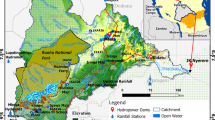Abstract
The objective of this study was to test indicators and improve the assessment of groundwater sustainability by using a synthetic method. An indicator system of groundwater sustainability was constructed under the framework of driver–pressure–state–impact–response, and a method for the assessment of groundwater sustainability was developed by using analytic hierarchy process together with information entropy theory. This method was used to calculate the weight of each indicator. And then, the sustainability scale was determined by the indicator zoning methods. The assessment results of a case study in Hohhot Plain, China, demonstrated that the method greatly reduced the randomicity and anthropogenic influence on the determination of weight of indicators; and gave a quantitative classification on sustainability scale which produced a rational result on the assessment of groundwater sustainability in Hohhot Plain.








Similar content being viewed by others

References
Alley WM, Reilly TE, Franke OL (1999) Sustainability of ground-water resources. U.S. Geological Survey Circular 1186
Biswas AK (1988) Sustainable water development for develo** countries. Water Resour Dev 4(4):232–250
Bithas K (2008) The sustainable residential water use: sustainability, efficiency and social equity, the European experience. Ecol Econ 68:221–229
Chaves HML, Alipaz S (2007) An integrated indicator based on basin hydrology, environment, life, and policy: the watershed sustainability index. Water Resour Manag 21(5):883–895
Custodio E, Kretsinger V, Llamas MR (2005) Intensive development of groundwater: concepts, facts and suggestions. Water Policy 7:151–162
Dillon PJ (2005) Future management of aquifer recharge. Hydrogeology 13:313–316
Fleckenstein J, Krause S, Hannah DM, Boano F (2010) Groundwater-surface water interactions: new methods and models to improve understanding of processes and dynamics. Adv Water Resour 33(11):1291–1295
Foster S (2006) Groundwater-sustainability issues and governance needs. Episodes 29(4):238–243
Hirata R, Suhogusoff A, Fernandes A (2007) Groundwater resources in the State of São Paulo (Brazil): the application of indicators. Anais da Academia Brasileira de Ciências 79(1):141–152
Hoekstra AY (2009) Human appropriation of natural capital: a comparison of ecological footprint and water footprint analysis. Ecol Econ 68(7):1963–1974
Juwana I, Perera BJC, Muttil N (2009) Conceptual framework for the development of West Java water sustainability index. 18th World IMACS/MODSIM Congress, Cairns
Kuzmana MK, Groˇselja P, Ayrilmis N et al (2013) Comparison of passive house construction types using analytic hierarchy process. Energy Build 64:258–263
Lamba´n LJ, Martos S, Rodrı´guez-Rodrı´guez M, Rubio JC (2011) Application of groundwater sustainability indicators to the carbonate aquifer of the Sierra de Becerrero (Southern Spain). Environ Earth Sci 64:1835–1848
Lavapuro M (2008) Groundwater sustainability indicators testing with Finnish data. Boreal Environ Res 13:381–402
Liao Y, Xu J, Wang W (2011) A method of water quality assessment based on biomonitoring and multiclass support vector machine. Proc Environ Sci 10:451–457
Liu J, Rich K, Zheng C (2008) Sustainability analysis of groundwater resources in a coastal aquifer, Alabama. Environ Geol 54:43–52
Loucks DP, Gladwell JS (1999) Sustainability criteria for water resource systems. Cambridge University Press, Cambridge
Lutz A, Thomas JM, Pohll G, Keita M, McKay WA (2008) Sustainability of groundwater in Mali, West Africa. Environ Earth Sci 58:1441–1450
Meadows D (1998) Indicators and information systems for sustainable development: a report to the Balaton. The Sustainability Institute, Balaton Group
Menon S (2007) Groundwater management: need for sustainable approach. MPRA (Munich Personal RePEc Archieve) paper
Palme U, Tillman AM (2008) Sustainable development indicators: how are they used in Swedish water utilities? J Clean Prod 16:1346–1357
Pandey VP, Shrestha S, Chapagain SK, Kazama F (2011) A framework for measuring groundwater sustainability. Environ Sci Policy 14:396–407
Policy Research Initiative (2007) Canadian water sustainability index. PRI Project Report on Sustainable Development
Rijsberman FR (2006) Water scarcity: fact or fiction? Agric Water Manag 80:5–22
Scanlon BR, Healy RW, Cook PG (2002) Choosing appropriate techniques for quantifying groundwater recharge. Hydrogeology 10:18–39
Sharma BR (1999) Regional salt and water-balance modeling for sustainable irrigated agriculture. Agric Water Manag 40:129–134
Vrba J, Lipponen A (2007) Groundwater resources sustainability indicators. IHP-Viseries on groundwater no. 14
Zhang GH (2009) Theory and methodology of regional groundwater function and sustainable utilization assessment in China. Geology Pressing House, China
Zheng C, Wang P (1996) Parameter structure identification using tabu search and simulated annealing. Adv Water Resour 19(4):215–224
Acknowledgments
This study was financially supported of the China Geolgoy Survey, Grant No. 1212010913010. Constructive suggestions and comments on the manuscript from the reviewers are very much appreciated.
Author information
Authors and Affiliations
Corresponding author
Rights and permissions
About this article
Cite this article
Chen, J., Zhang, Y., Chen, Z. et al. Improving assessment of groundwater sustainability with analytic hierarchy process and information entropy method: a case study of the Hohhot Plain, China. Environ Earth Sci 73, 2353–2363 (2015). https://doi.org/10.1007/s12665-014-3583-0
Received:
Accepted:
Published:
Issue Date:
DOI: https://doi.org/10.1007/s12665-014-3583-0



